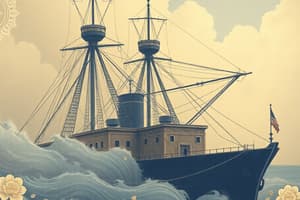Podcast
Questions and Answers
Considering the operational tempo of modern naval logistics, what is the most critical implication of failing to deliver the 'right part' in alignment with the Naval Logistics mission?
Considering the operational tempo of modern naval logistics, what is the most critical implication of failing to deliver the 'right part' in alignment with the Naval Logistics mission?
- Minor delays in routine maintenance schedules.
- An increased cost in transportation due to expedited shipping.
- A slight decrease in overall fleet readiness statistics.
- Potential mission degradation or failure due to critical system downtime. (correct)
In the context of naval supply chain management, what is the primary challenge addressed by the Consolidated Afloat Requisition Guide Overseas (CARGO)?
In the context of naval supply chain management, what is the primary challenge addressed by the Consolidated Afloat Requisition Guide Overseas (CARGO)?
- Streamlining the procurement process for goods from foreign vendors.
- Managing the disposal of excess inventory from decommissioned ships.
- Standardizing requisition procedures for all branches of the U.S. military.
- Ensuring efficient and compliant procurement and delivery of supplies to naval vessels operating abroad. (correct)
How does the 'Fleet Freight/Cargo' message enhance operational readiness beyond simply routing material to a ship during RAS or port visits?
How does the 'Fleet Freight/Cargo' message enhance operational readiness beyond simply routing material to a ship during RAS or port visits?
- By providing real-time updates on sailors' personal mail.
- By tracking fuel consumption rates for each vessel.
- By automating customs declarations for international ports.
- By optimizing resource allocation through improved visibility of incoming critical supplies to different vessel locations. (correct)
Considering the 'Never Out List,' what strategic advantage does maintaining a consistent stock of items such as toilet paper, printer paper, gloves, and pens provide to a naval vessel's operational capability?
Considering the 'Never Out List,' what strategic advantage does maintaining a consistent stock of items such as toilet paper, printer paper, gloves, and pens provide to a naval vessel's operational capability?
When considering Depot Level Repairables (DLRs), what factors primarily determine whether a part should be economically repaired and returned to the fleet versus being discarded?
When considering Depot Level Repairables (DLRs), what factors primarily determine whether a part should be economically repaired and returned to the fleet versus being discarded?
In the context of Depot Level Repair (DLR) parts, what is the most significant logistical impact of a 'Remain in Place' (RIP) procedure approved by NAVSUP WSS?
In the context of Depot Level Repair (DLR) parts, what is the most significant logistical impact of a 'Remain in Place' (RIP) procedure approved by NAVSUP WSS?
Considering the use of Maintenance Assistance Modules (MAMs), how do these tools contribute to increasing the self-sufficiency of naval vessels in performing complex repairs at sea?
Considering the use of Maintenance Assistance Modules (MAMs), how do these tools contribute to increasing the self-sufficiency of naval vessels in performing complex repairs at sea?
What inherent security risk is most amplified when using the NavyCash card system, and how do current protocols mitigate this risk?
What inherent security risk is most amplified when using the NavyCash card system, and how do current protocols mitigate this risk?
How do the profits generated from a ship's store, allocated to MWR, directly enhance the Navy's strategic goals?
How do the profits generated from a ship's store, allocated to MWR, directly enhance the Navy's strategic goals?
Considering the Basic Daily Food Allowance (BDFA), what is the most complex variable that contributes to its quarterly adjustment of the rate?
Considering the Basic Daily Food Allowance (BDFA), what is the most complex variable that contributes to its quarterly adjustment of the rate?
Flashcards
Mission of Naval Logistics
Mission of Naval Logistics
The mission of Naval Logistics ensures the right part is at the right place at the right time.
CARGO
CARGO
Consolidated Afloat Requisition Guide Overseas.
Purpose of Fleet Freight/Cargo message
Purpose of Fleet Freight/Cargo message
Routes materials to wherever the ship is during operations like RAS or port visits.
"Never Out List" purpose
"Never Out List" purpose
Signup and view all the flashcards
Depot Level Repairable (DLR) parts
Depot Level Repairable (DLR) parts
Signup and view all the flashcards
Remain in Place (RIP)
Remain in Place (RIP)
Signup and view all the flashcards
Maintenance Assist Modules (MAM)
Maintenance Assist Modules (MAM)
Signup and view all the flashcards
Basic Daily Food Allowance (BDFA)
Basic Daily Food Allowance (BDFA)
Signup and view all the flashcards
Six Categories of Hazmat
Six Categories of Hazmat
Signup and view all the flashcards
CASREP
CASREP
Signup and view all the flashcards
Study Notes
- The mission of Naval Logistics is to ensure the right part is at the right place at the right time.
- CARGO is the Consolidated Afloat Requisition Guide Overseas.
- The Fleet Freight/Cargo message is for routing material to wherever the ship is, such as during Replenishment at Sea (RAS) or a port visit.
- A "Never Out List" contains material the ship must always have on hand, including toilet paper, printer paper, gloves, and pens.
Depot Level Repair (DLR)
- DLR stands for Depot Level Repairable.
- These parts are maintained by the Navy, economically repaired, and then redistributed to the fleet.
- 5G Advice Code indicates providing the part to Supply.
- 5S Advice Code indicates the part remains in the system.
Remain in Place (RIP)
- RIP authorizes a DLR part to remain in place until it is replaced with a new one.
- This replacement must be approved by NAVSUP WSS.
Maintenance Assist Modules (MAM)
- MAM is a maintenance assistant module.
- MAMs are used for troubleshooting equipment.
Navy Cash Program
- The Navy Cash program is a cashless system.
- NavyCash cards can be used both on ship and ashore.
- Funds can be transferred at NavyCash ATMs on the ship.
- The ship's chip is used on the ship, while the strip is used ashore.
- Profits from the ship's store go to MWR (Morale, Welfare, and Recreation).
Basic Daily Food Allowance (BDFA)
- BDFA stands for Basic Daily Food Allowance.
- It is the amount each person is allowed for food per day.
- The current amount is $11.06 and changes quarterly.
- The DCA (Damage Control Assistant) is in charge of battle rations.
- LT HURST is the Supply Officer.
- LTJG HUGHEY is the Disbursing Officer.
Hazmat Categories
- The six categories of Hazmat are: Flammable, Aerosol, Toxic, Corrosive, Oxidizing, and Combustible.
- Throwing plastic over the side is prohibited, regardless of nautical miles.
- Metal can be thrown over the side at a minimum of 12 nautical miles.
- Pultable trash can be thrown over the side at a minimum of 3 nautical miles.
- Hazmat spill kits are located at the Aft Decon station, Vending machine P-way, and Port Break.
CASREP
- CASREP stands for Casualty Report.
- CAT2, CAT3, and CAT4 are categories of casualty reports.
Studying That Suits You
Use AI to generate personalized quizzes and flashcards to suit your learning preferences.




